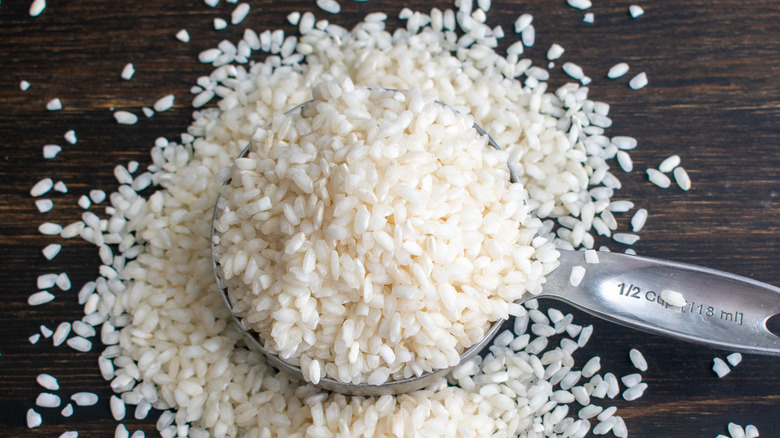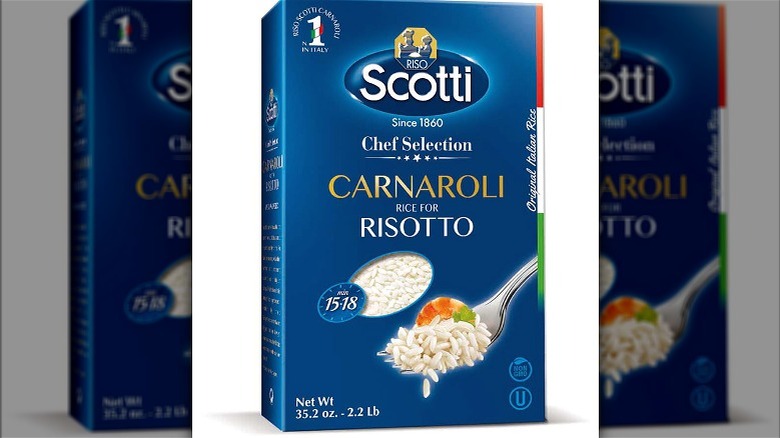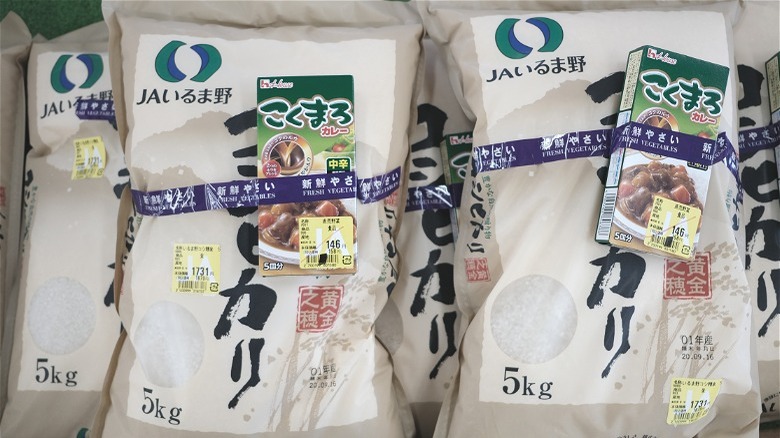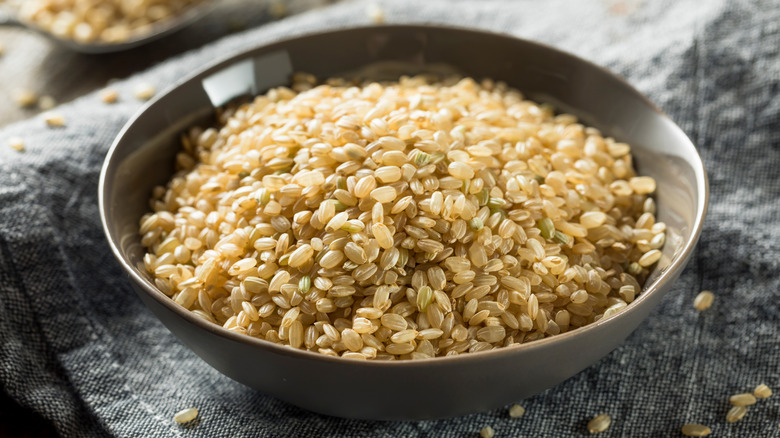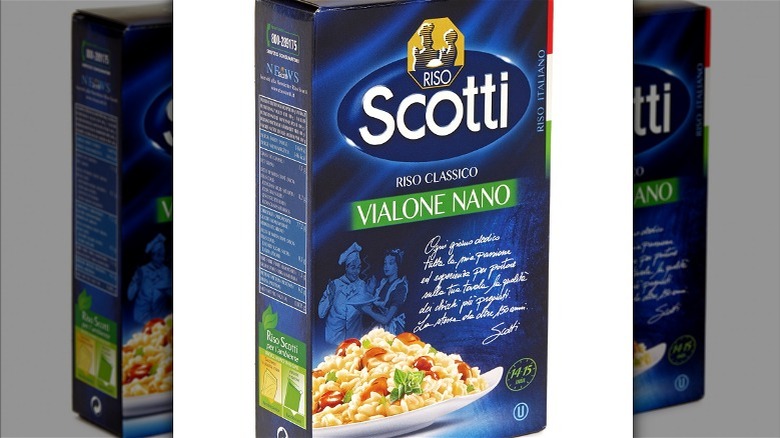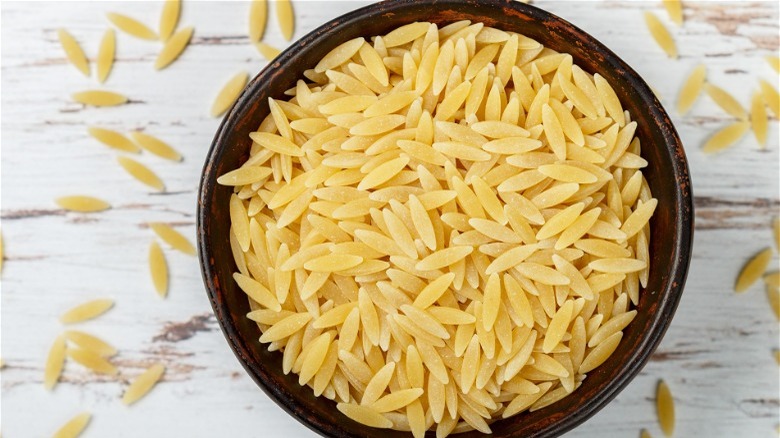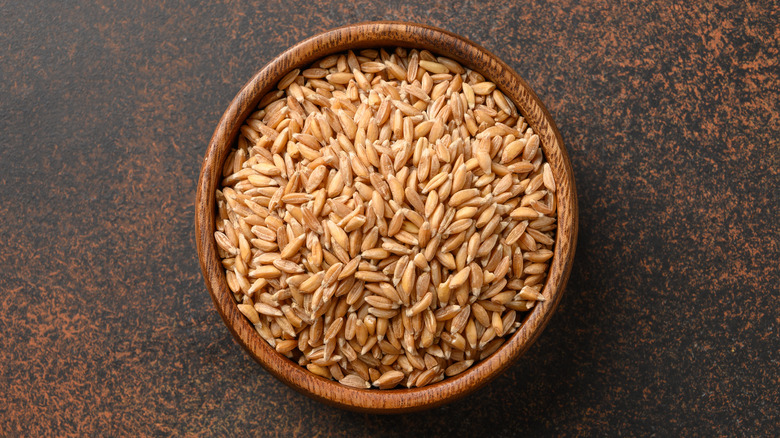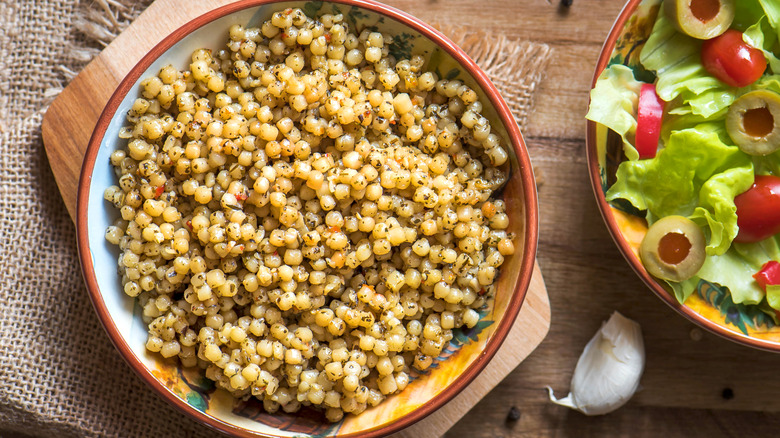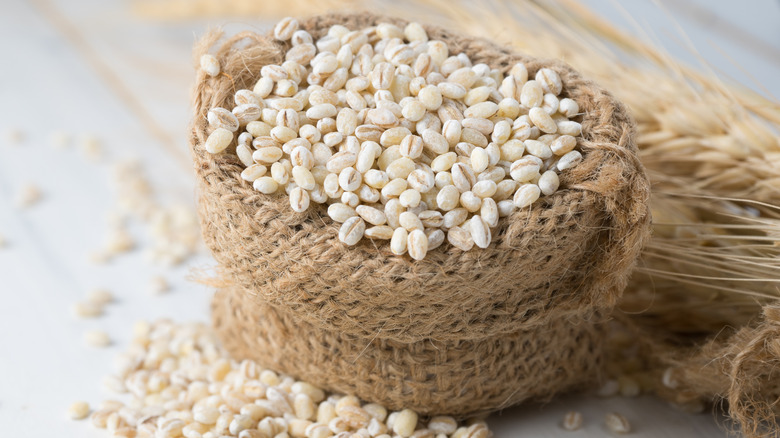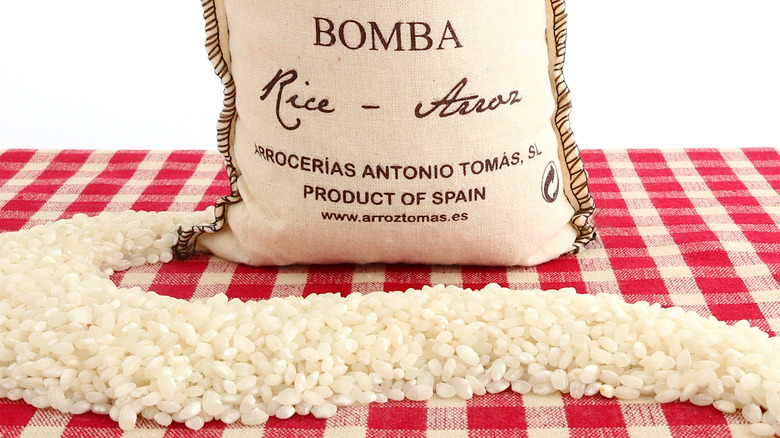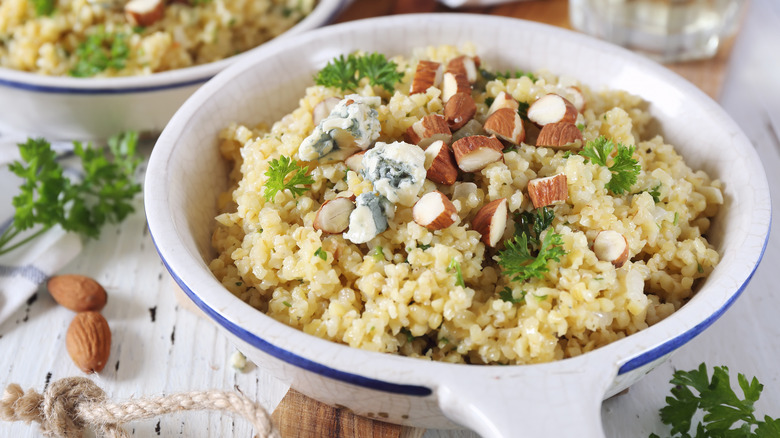10 Best Substitutes For Arborio Rice
We may receive a commission on purchases made from links.
Whether you're creating a risotto with mushrooms or peas, Arborio rice is probably the grain you'll reach for. A type of medium-grain rice that was first grown in Italy, Arborio is named for the region where it originated, according to MasterClass. Arborio, which has small, white, oval-shaped grains, continues to be cultivated in Italy today, as well as the U.S. This rice is very high in the type of starch known as amylopectin, and because it is only lightly milled, much of that starch stays intact within the grains. While some types of rice call for rinsing before cooking to wash away excess starch, you want to keep the starch in Arborio to achieve a dish with a creamy texture. This way, it also retains a bit of pleasant chewiness when cooked.
Arborio is best known for its ability to create a classic, creamy risotto, and it can be used in many other dishes as well. It's especially nice in recipes where it can soak up flavorful cooking liquids and add body to the dish. The al dente bite that Arborio rice maintains after cooking is also one of its traits that is prized by cooks. But when you don't have any Arborio on hand, here are 10 ingredients that you can use as a substitute. Be sure to have plenty of hot stock on hand to keep these Arborio-adjacent ingredients from drying out as they cook.
1. Carnaroli rice
Carnaroli is another type of Italian rice with slightly longer grains that are also high in starch, according to The Kitchn, and it's sometimes called the "king" of risotto rices. It can be slowly cooked to create a creamy texture with a bit of al dente bite just like Arborio. However, it actually cooks up more reliably, some cooks say. While Arborio rice has to be cooked and stirred just enough so that the rice becomes creamy but not gummy, Carnaroli is more forgiving, keeping its shape and chewiness even when it's stirred a little too much. This can be especially helpful for less experienced cooks.
Even though Carnaroli may be a better type of rice for making risotto, DelightedCooking says it is one of the most expensive types of rice and that it might be harder to find than Arborio. Check for Carnaroli rice in stores specializing in Italian foods or online.
Carnaroli can be used as a 1:1 substitute for Arborio.
2. Japanese rice
Another rice that can be used in place of Arborio is Japanese rice, according to The Kitchn, which shares that short-grain rice like this one works well in place of the medium-grain Arborio. Just One Cookbook shares that oftentimes Japanese rice is referred to as sticky rice because of its use in dishes like rice balls. Other sources and even product packaging may also use the term sushi rice when referring to Japanese rice, even though true sushi rice is steam-cooked with vinegar and seasoning before it's used in sushi dishes. Ultimately, uruchimai is the type of Japanese rice you'll want to look for as a substitute for Arborio. Avoid the mochigome type of sweet Japanese rice, which is used to make mochi sweets and is a more gelatinous rice than uruchimai.
You can use Japanese rice in the same proportion as you would for Italian rice, as is done in a Bon Appétit risotto recipe.
3. Brown rice
Instead of using Arborio rice to make risotto, you can swap it for brown rice. Healthline explains that unlike white rice, brown rice grains have their bran and germ still intact. This gives brown rice a nutritional advantage, as well as a heartier flavor and texture that can be delicious in risotto. Be sure to look for short-grain brown rice, which has squatter, oval-shaped grains, because it has more of the desirable starch than long-grain varieties.
Keep in mind that brown rice does require a longer cooking time than white rice. In the recipe for sweet corn brown rice risotto on Martha Stewart's website, the process of slowly adding broth and stirring the rice takes about 40 minutes rather than 20. Healthy Seasonal Recipes shares another method in a recipe for brown rice risotto with peas: Allow the rice to cook covered and untouched for about 40 minutes, then stir shredded cheese into the rice at the end to enhance the creamy texture. The recipe also notes that it's important to not let all of the liquid evaporate and to add a splash more if the rice seems to be drying out.
Use a 1:1 swap for Arborio rice and brown rice.
4. Vialone Nano rice
Vialone Nano is classified as a semifino rice, which is an Italian designation for rice that, when cooked, has a bite in the center with a soft exterior, according to Garrubbo Guide. This Italian rice consists of smaller, rounded grains that can absorb a great deal of liquid when cooked (via Smart Kitchen). This makes it a great choice for risotto or arancini, for which the goal is for the rice to gradually absorb the cooking liquid and become creamy and soft. Vialone Nano also keeps its shape when cooked instead of turning to mush. It's a favorite for risotto in the Veneto region of Italy, which includes the city of Venice, while Arborio or Carnaroli are preferred in much of the rest of the country.
Fitibility shares that, like Carnaroli, Vialone Nano may be more expensive and not as easy to find as Arborio. Check markets specializing in imported Italian foods or with online sellers.
Use this rice in the same amount as you would Arborio in recipes.
5. Orzo
Orzo is in the class of pasta known as pastina, or small pasta, according to MasterClass. The tiny pieces are made to resemble the size and shape of grains of rice, but they are made with semolina flour and water. The tiny pasta can be used in risotto in place of Arborio rice. When cooked, orzo gives "risotto" the same look as rice does but provides a less chewy, more delicate texture.
Although orzo doesn't contain the amylopectin starch found in Arborio rice, you can still get a creamy texture by cooking the same way you'd make risotto. In Italy, this method of cooking orzo results in a dish called orzotto. The starch present in the pasta from the semolina flour creates creaminess and helps the sauce cling. Orzo cooks quickly, so be sure not to overdo it: It should have an al dente firmness when ready.
You can use a 1:1 ratio in most recipes when substituting orzo for rice. Just keep in mind that if you're making something like risotto, orzo doesn't take as long to cook and therefore won't need as much liquid as rice does. Taste as you go to ensure the best texture.
6. Farro
Farro is categorized as an ancient grain and is a solid source of many vitamins and minerals. Farro that's typically found in stores has been pearled, a process that removes some of the outer layers of bran and helps to shorten the cooking time. Farro also shares a desirable characteristic of Arborio rice: It retains some chewiness even after it's fully cooked. This makes farro an intriguing and heartier option to swap in for Arborio rice in risotto.
It's usually recommended to soak farro before cooking to help it become tender more quickly, although pearled farro won't need as long of a soaking time. In Giada De Laurentiis' recipe for farro risotto (shared on Food Network), the farro grains are soaked for 30 minutes before getting cooked with aromatics and white wine. De Laurentiis cooks the farro using the traditional risotto technique of stirring hot broth in a little at a time, letting it absorb before adding more. This recipe is ideal for those wanting a lighter take on risotto, though if you want something creamier, you can stir in cheese and cream at the end since farro's starches don't become as thick as those in rice.
Use the same amount of farro in place of Arborio rice in your recipes.
7. Israeli couscous
This Arborio rice substitute isn't a grain at all, but actually a type of pasta. According to MasterClass, Israeli couscous is made from a mixture of semolina flour and water. True couscous consists of tiny, irregularly shaped balls that are traditionally made by hand. Israeli couscous, however, is made by machines to create balls that are larger and more uniform. You may find this pasta under different names, including pearl couscous, ptitim, or giant couscous. Israeli couscous can be toasted before being cooked or prepared like pasta by adding it to boiling water and draining the water away when it's done.
Epicurious notes that Israeli couscous is larger than Arborio. However, it does have a pleasant texture with just enough al dente chewiness, and it can be prepared to slowly take in the flavorful broth and aromatics that it cooks in.
To substitute Israeli couscous for Arborio rice in recipes, use a 1:1 swap.
8. Pearled barley
Barley is a hearty grain that can stand in for Arborio rice to make a risotto that's creamy and also more hearty and filling. Although you can find hulled barley that's considered whole-grain, The Kitchn shares that pearled barley is easier to find at stores and less expensive. Pearling removes the outer layers of bran to leave a lighter grain that cooks quickly and soaks up whatever flavorful liquid it's cooked in. Another advantage of choosing pearled barley for your risotto is that the starches from the grains are released as they cook, which means it's possible to get a creamy texture while retaining some chewiness.
As with farro, you can take a traditional approach to making risotto with pearled barley: Toast the grains first and then add stock ladleful by ladleful to let it absorb, like in a Taste of Home recipe for barley risotto. Other recipes cook the barley by adding all of the cooking liquid to the grains at once and letting them simmer, as with the barley, chicken, and mushroom risotto from BBC Good Food.
Use the same amount of barley when substituting it for Arborio rice in recipes.
9. Bomba rice
Although risotto is traditionally made with Italian rice varieties, J. Kenji López-Alt shares on Serious Eats that bomba makes "a very fine risotto, despite the fact that it comes from the wrong country." Bomba rice is produced in Spain, is a short-grain variety, and contains moderate levels of the starch found in Arborio rice.
Bomba is a more labor-intensive rice to produce, according to La Tienda, because it takes more time to become mature. In its final packaged form, it's highly dehydrated, which contributes to the most intriguing characteristic of bomba: It can absorb up to three times its volume in cooking liquid. Because it doesn't release a lot of starch, bomba rice keeps its shape and chewiness when cooked. The Spanish rice is considered the best type for making paella and is often packaged under the name of "paella rice." For that reason, it won't be as creamy or self-saucing as Arborio in risotto, but it will still work very well.
Use equal amounts of bomba rice for Arborio rice in modified recipes.
10. Bulgur wheat
Most familiar as the main ingredient in tabbouleh, bulgur wheat is a versatile ingredient that can be used in many dishes. Bulgur is made by cracking and partially cooking whole grains of wheat, which are then dehydrated and packaged for sale. Bulgur cooks up more quickly than other whole grains and has a nutty, chewy texture.
Because bulgur can be cooked to a creamy, thickened texture with a pleasant chewiness, it makes an intriguing substitute for Arborio rice to make a hearty risotto. Chef Nadiya Hussain likes risotto made with bulgur: In her recipe for squid bulgur wheat risotto (shared on The Happy Foodie), she builds in flavor with onion, cumin seeds, and fish stock before topping the dish with fried squid rings. Hussein prepares the bulgur using the risotto method of first toasting the grains and then adding stock slowly one ladle at a time, stirring until the stock is absorbed before adding more.
Use a 1:1 ratio when swapping bulgur wheat for Arborio rice in recipes.
